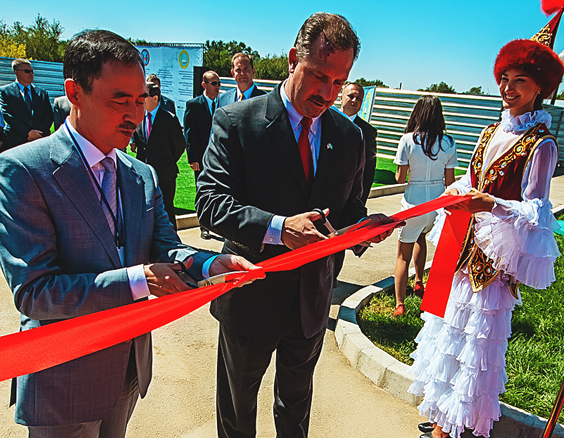This article is part of World War “V”: The COVID-19 Pandemic, a collection of all CNS COVID-19-related articles.
May 18, 2020
Andrew Weber
Richard Pilch
Recently, some voices in China and the Russian Federation have questioned the impetus for the Republic of Kazakhstan’s new national biosafety level (BSL)-2 and BSL-3 laboratory, which was established in partnership with the United States. [1] Construction of the laboratory was funded by the US Department of Defense’s Cooperative Threat Reduction (CTR) program, [2] which for more than two decades has partnered with nations around the world – including Russia [3] and China [4] – to reduce the threat of weapons of mass destruction (WMD) and naturally occurring infectious diseases of global concern. As COVID-19 has demonstrated, these naturally occurring diseases pose a serious risk, not only to local populations but to regional and international populations as well.

Opening ceremony, Source: www.hnc.usace.army.mil, William S. Farrow
In Kazakhstan, high-risk, naturally occurring diseases include Crimean Congo hemorrhagic fever (CCHF), hemorrhagic fever with renal syndrome (hantaviruses), tickborne encephalitis (TBE), rickettsial diseases, and Q fever. [5] Historically, Kazakhstan monitored these diseases in laboratories of the former Soviet anti-plague system (APS), [6] which fell into severe disrepair after the collapse of the Soviet Union and the subsequent lack of funding. As a result, the potential for accidents and mishaps in these labs compounded the risk to surrounding populations.
The central APS laboratory in Kazakhstan, called the Kazakh Scientific Center for Quarantine and Zoonotic Diseases (KSCQZD), housed the most dangerous activities to this end. The work it routinely conducted required international biosafety level (BSL)-2 and BSL-3 standards spanning personnel practices, safety equipment, and facility administrative and engineering controls. When the United States engaged with this lab through the CTR program, none of these controls had been in place.
A Joint Agreement
Kazakhstan and the United States jointly agreed to construct a new, national BSL-2 and BSL-3 laboratory called the Central Reference Laboratory (CRL) to replace KSCQZD, after which the original facility would be fully decommissioned. The US funded the CRL’s construction, while Kazakhstan assumed full operational ownership and funding of the facility upon construction completion. The CRL formally opened its doors on January 1, 2020, and currently provides the national testing capability for COVID-19. [7]
Russia and China raise valid safety concerns regarding the increasing number of laboratories around the world that work with dangerous biological agents like SARS-CoV-2. Such laboratories are necessary to understand and address infectious diseases. They do, however, pose a significant biosafety risk, whether they’re located in Russia, China, Kazakhstan, the United States, or anywhere else. [8] Laboratory-acquired infections happen: one review identified more than 1,000 of them over a 25-year period, or approaching 1 infection per week on average. [9] An international dialogue is long overdue to establish standards for consolidating the global laboratory footprint based on scientific and public health need and cumulative risk. But in the case of Kazakhstan, replacing KSCQZD’s substandard facility with an international standard CRL has unequivocally reduced the risk of both natural infectious disease and laboratory accidents that might impact the region and world.
The new US-funded lab in Kazakhstan reduces natural infectious disease and laboratory accident risks.
–Dr. Richard Pilch, MD, MPH
It is also true that laboratories like the CRL – and similar laboratories in Russia, China, the United States, and elsewhere – are inherently dual-use in nature, meaning that the same biological agents, equipment, and expertise required for peaceful research could be diverted toward weapons-related applications with relative ease. Such activity would be in breach of the 1972 Biological Weapons Convention (BWC), a multilateral disarmament treaty of 183 states parties – including Russia, China, Kazakhstan, and the United States – that prohibits biological-weapons development and related activities. Kazakhstan regularly submits confidence-building measures under the BWC demonstrating its compliance with the Convention, and provides assurances to regional neighbors and other states parties that no such activities are being conducted. However, the only way to know for certain is to cooperate.
Collaboration for the Greater Good
Kazakhstan, Russia, and China must work together to prevent, detect, and respond to the infectious disease threats that endanger the region. Such partnership is critical not only to enable early warning and management of public health emergencies of international concern, but also to improve the global community’s understanding of these biological agents and enable development of targeted countermeasures that serve the greater good. Most importantly, it is critical to establishing transparency and trust. As Kazakhstan opens the CRL’s doors to its neighbors, the United States, WHO, and other international stakeholders can only hope that a new era of much-needed collaboration is born.
Infectious diseases do not respect borders. In order to be effective, the regional and global efforts to address them must follow suit.
The Honorable Andrew Weber is Senior Fellow at the Council on Strategic Risks. He previously served as Assistant Secretary of Defense for Nuclear, Chemical, and Biological Defense Programs under the Obama Administration.
Dr. Richard Pilch is the Director of the Chemical and Biological Weapons Nonproliferation Program at the James Martin Center for Nonproliferation Studies (CNS), Middlebury Institute of International Studies at Monterey (MIIS).
Notes
[1] See, for example, https://www.newsweek.com/china-russia-unite-condemn-hazardous-american-laboratories-former-soviet-states-1500952[2] See, for example, https://www.ncbi.nlm.nih.gov/pmc/articles/PMC6958332/
[3] See, for example, http://www.istc.int/en/article/7528; https://www.russiamatters.org/facts/cooperative-threat-reduction-timeline
[4] See, for example, https://www.energy.gov/articles/us-energy-secretary-moniz-and-chinese-atomic-energy-authority-open-new-nuclear-security; https://obamawhitehouse.archives.gov/the-press-office/2016/03/31/us-china-joint-statement-nuclear-security-cooperation
[5] https://www.ncbi.nlm.nih.gov/pubmed/26870722/
[6] https://nonproliferation.org/stories-soviet-anti-plague-system/; https://nonproliferation.org/the-soviet-anti-plague-system/
[7] https://www.facebook.com/byelzhan/posts/2607733202628489
[8] See, for example, https://www.usatoday.com/story/news/2015/05/28/biolabs-pathogens-location-incidents/26587505/; https://www.gao.gov/products/GAO-08-108T; https://www.ncbi.nlm.nih.gov/pmc/articles/PMC174631/pdf/080389.pdf
[9] Harding AL, Byers KB. Epidemiology of laboratory-associated infections. In: Fleming DO, Hunt DL, eds. Biological safety: principles and practices. 3rd ed. Washington, DC: ASM Press; 2000:35–54.
